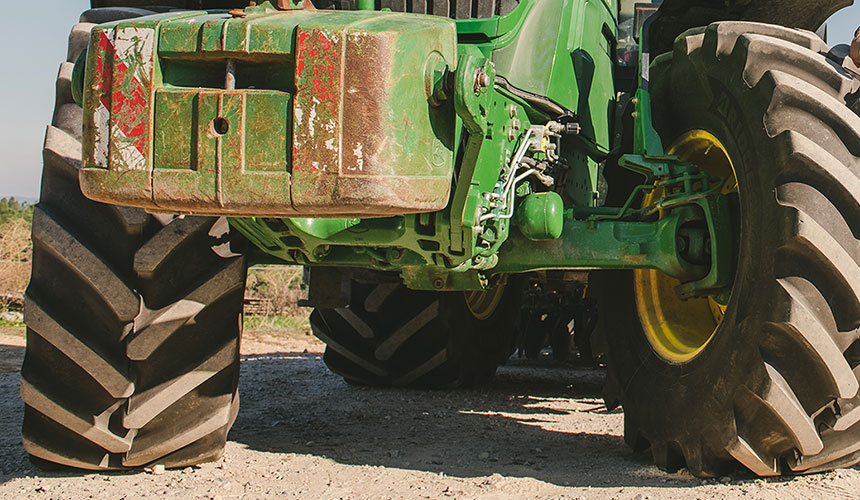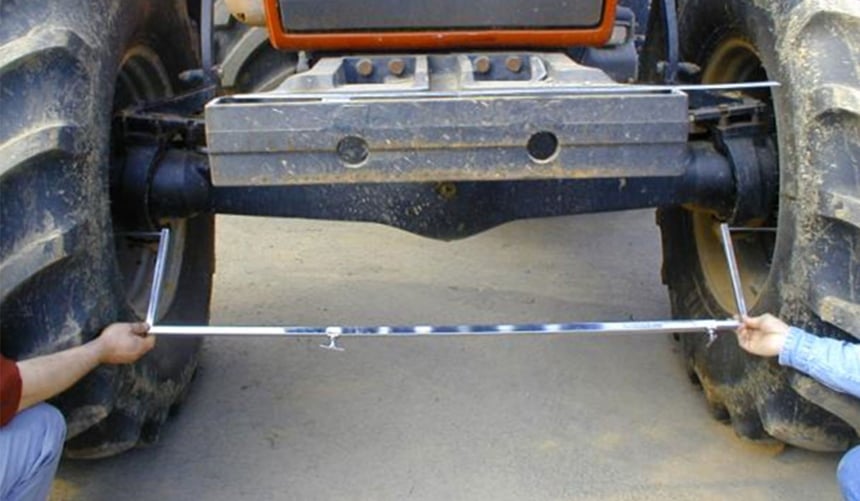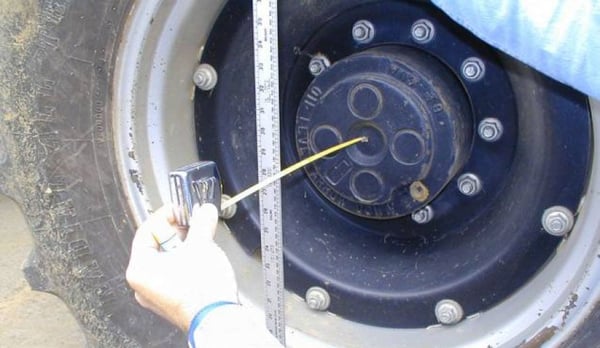Irregular wear to your tractor tyres is an early warning sign. Whether the tyre is worn on the inside or outside, there is probably a problem with the alignment, which is one of the main adjustment problems in agricultural tyres, which include incorrect parallelism.
Over a certain period, this defect can cause up to 30% more wear to the tyres than if the problem is corrected. This represents a considerable cost for your farm when you consider the price of replacing the tyres on your tractor or farm machinery.
Parallelism or camber angle? How to tell the difference
Parallelism, like camber angle, relates to the incorrect angle of your tractor wheels.
However, it is important to understand the difference between these two alignment problems to make the right adjustments.
- Parallelism is the horizontal axis of the wheels in relation to the axis of the axle.
When facing the tractor, the wheels should be parallel to the tractor’s longitudinal axis. - Camber angle is the angle between the vertical axis of the wheels used for steering and the vertical axis of the vehicle.
The wheels must be perfectly vertical to the ground to ensure that the tractor grips properly.
How to recognise an alignment problem
There are several warning signs for wheel misalignment. By closely observing your tyres, you can detect the problem very quickly.
Here are the types of wear that are due to misalignment:
- The tyres are more worn on one side, either the inside or the outside.
- When driving on a smooth surface such as a flat road, your tractor pulls slightly to left or to right.
- You can feel abnormal vibrations when you accelerate.
- You are constantly having to adjust your steering when driving in a straight line.
These indications could be caused by other problems, such as the slope of a field or a road (slant or convex road).
But generally, the alignment needs to be corrected, the lugs are worn down symmetrically, towards the inside or the outside, on the right tyre or the left tyre.
The different types of defect: camber angle or parallelism
Camber can be positive or negative depending on the angle of the tyres in relation to the ground:
- Positive camber: if the top of the tyre is further out than the bottom in contact with the soil. It’s the tyre’s external lugs that are being worn down excessively.
- Negative camber: if the bottom of the tyre, in contact with the ground, is further out than the top of the tyre, the tyre is being worn down more on the inside.
When talking about parallelism we speak about toe in or toe out depending on the angle to the horizontal axle:
- Toe in: if the front of the tyre turns inwards. This will wear down the outside of the tyres.
- Toe out: if the front of the tyre turns outwards, the inside of the tyre will be worn down more quickly.
What to do in case of misalignment?
 As soon as you spot any abnormal wear to your tyres, the first thing to do is to check the alignment.
As soon as you spot any abnormal wear to your tyres, the first thing to do is to check the alignment.
In cases of misalignment, the front tyres will generally wear down more than the rear tyres.
- If the damage is too great: you will need to consider changing the tyres to maintain the tractive capacity of your machinery as well as your safety.
- If there is only slight damage and at least a third of the lug height remaining on the damaged part of the tyres, then you can swap the tyres around to make use of the undamaged lugs.
How to synchronise the parallelism?
To synchronise the parallelism, always refer to the user manual provided by the manufacturer. Generally, there is a small tolerance threshold within which the tyres will not be damaged. This tolerance ranges from 0 to 2 mm, whether the tractor is a two or four-wheel drive.

These are the different steps to follow to check if your wheels’ toe in or toe out is excessive:
First step:-
- Place the tractor on a flat, hard and stable surface. This is essential to guarantee the exactitude of the measurements taken later.
- Inflate the tyres to the same pressure.
Second step:
-
- Measure the height of the centre of the hub on the front wheels. Ensure that the measuring tool is perfectly perpendicular to the ground.
- To confirm that this measurement is correct, measure both hubs.

Third step:
-
- Mark the height of the hub on the side of the rim (front and back).

Fourth step:
-
- Measure the distance between the two points respectively at the front and the back.
If the distance between the two back marks is smaller than the distance between the two front markings, you have toe out.
And if the distance between the two front marks is smaller than that between the two back markings, then you have toe in.
- Measure the distance between the two points respectively at the front and the back.

How to adjust the parallelism?
If you detect a problem with the parallelism, you must adjust the wheels to achieve the tolerance threshold.
To do this, rotate the steering ball joint slightly.
- After removing the locknut which blocks the joint, turn it slightly one way or the other depending on the adjustment required.
- After adjusting, measure the wheels again to ensure that the problem has been corrected.
It is advisable to adjust the parallelism with an opening of 2 mm, to compensate for the constraint to which the front axle is subjected when in use.
TIP: check your parallelism regularly
It is important to check your tractor’s parallelism measurements regularly. Ruts, vibrations, unlevel terrain… can combine on a daily basis to create toe in or toe out progressively, without you noticing.
Some minor adjustments implemented periodically can save you a considerable amount of money.
- For a misalignment of 5 mm, your tyres will lose 12% of their lifespan.
- At 15 mm (toe in or toe out), this can rise to 26% of the lifespan of your tyres.
The Bridgestone-agriculture.eu blog is written and administered by tractor tyre experts who are available to provide you with the advice you need on the subject of your agricultural tyres. They allow you to maximise your productivity with information on all subjects linked to tyres: Technical data for agricultural tyres – Agricultural tyre performance – Air pressure advice – Solutions to avoid soil compaction – Sprayer tyre pressure – Why and how to ballast your tractor tyres – etc…
To take it one step further and increase the profitability of your farm, les Experts du pneu provide a free, highly detailed eBook which explains the essential role of the agricultural tyre in your productivity..
Most people who read this article have also read some of the following articles:
This information is intended only to make you aware of the technical and functional aspects of agricultural tires and their use. It does not allow you to make a judgment or a definitive conclusion on a given problem. Only your agricultural tire expert is able to make a technical assessment and take a final decision, case by case.
Leave a
commentary
Your email address will not be published.
Required fields are indicated with *








